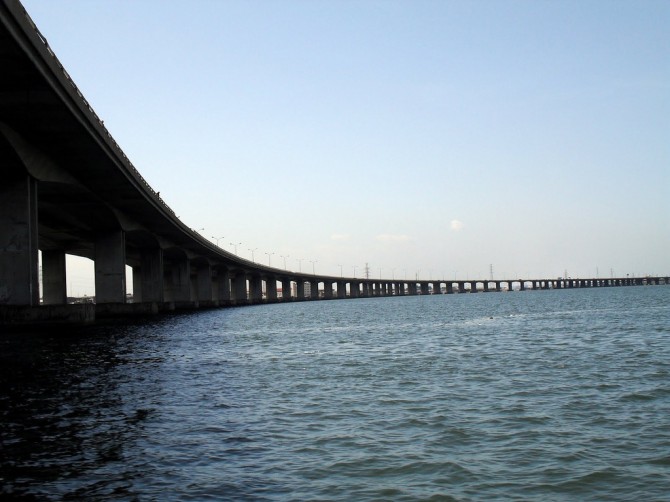A new report commissioned by Senator Gbenga Ashafa (Lagos East), Senator Oluremi Tinubu (Lagos Central) and Senator Ganiyu Solomon (Lagos West) has revealed that the longest bridge in Africa may be one of the most catastrophic disasters waiting to happen.
According to the report authored by NSD Divers & Engineers in collaboration with Concrete Structural Engineering Laboratory of the Yonsei University, South Korea, the bridge has 1,318 defective foundation piles.
The defects were discovered during underwater inspections using the latest tools available in the industry.
The report further added that the scope of the inspection covered soil erosion and accretion at the pile or lagoon bed interfaces, all of which showed grave conditions of concrete degradation and concrete materials in about 1,318 piles.
Consequent upon the inspections just conducted, the report noted that there “was concrete degradation and appreciable loss of concrete material in 46 foundation piles. There was extensive reinforcement bars deterioration in about 8 piles.
“There was extensive damage of confining steel caissons and progressive concrete spalling in 24 piles. There was also progressive caisson deterioration in 1,318 foundation piles,” the report said along with pictorial evidence that shows the state of the bridge.
In a cover letter attached to the report and addressed to the lawmakers, the report warned that the Third Mainland Bridge “is an accident waiting to happen unless the degradations are urgently arrested” to avert grave situations on Africa’s longest bridge.
Consequently, the report was the rationale behind a motion which Ashafa co-sponsored with 55 other senators, asking the Federal Government “to urgently conduct an investigation to ascertain the true state of the Third Mainland Bridge in Lagos”.
In the motion, the lawmaker explained that there had been incessant complaints of shifting and unusual vibrations on the bridge by commuters plying the bridge for quite some time, even after the Federal Government carried out repair works on the bridge.
He said a report produced by a company “experienced in underwater surveys indicated that the underwater metal casing, housing the concrete piles on which the bridge stands have rusted and this accounts for the vibration experience in some portions of the bridge.
This led to the closure of the bridge for repairs between July 7 and October 30, 2012”.
The lawmaker further noted that Professor JHT Kim, Head of The Concrete Structural Engineering Laboratory, Yousei University, Seoul Korea “came on research in December 2012 and conducted an underwater examination of the structures holding the bridge and reported that the damages to the structure was worse than what he had been briefed.”
He said that such abandonment could lead to the collapse of the bridge as was the case with the bridge over Mississippi River at Minneapolis in the United States on August 1, 2007 and Sungsu Bridge in seoul, South Korea on October 21, 1994 among others.
He therefore said the collapse of the bridge could lead to a huge loss of lives and worsen the traffic situation in Lagos, the commercial hub of Nigeria taking cognisance of an average number of 70,000 vehicles that ply the bridge on daily according to the Lagos State Ministry of Transportation.
The lawmaker urged the Federal Government “to carry out inspections on all over-water bridges in Nigeria to save them from further deterioration and collapse”.
Source: ThisDay

